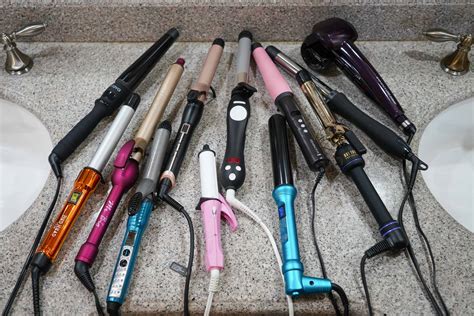If you’re like most women, you probably own a curling iron. But do you know what material it’s made of? And do you know if it’s the best material for your hair type?

In this article, we’ll take a look at the different materials used to make curling irons and their pros and cons. We’ll also help you choose the best material for your hair type and needs.
Types of Curling Iron Materials
Curling irons are typically made from one of four materials:
- Ceramic
- Tourmaline
- Titanium
-
Metal
Ceramic
Ceramic curling irons are a popular choice because they heat evenly and produce negative ions, which can help to reduce frizz and add shine to your hair. Ceramic irons are also relatively gentle on your hair, so they’re a good choice for people with fine or damaged hair.
Tourmaline
Tourmaline is a semi-precious gemstone that produces negative ions when heated. These ions can help to seal the hair cuticle, which can reduce frizz and add shine. Tourmaline irons are also known for their ability to create smooth, even curls.
Titanium
Titanium is a strong, lightweight metal that heats up quickly and evenly. Titanium irons are a good choice for people who want to create long-lasting curls. However, titanium ions can be harsh on your hair, so they’re not a good choice for people with fine or damaged hair.
Metal
Metal curling irons are the least expensive type of curling iron, but they’re also the most damaging to your hair. Metal ions can cause your hair to become dry, brittle, and frizzy. If you’re on a budget, a metal curling iron is a good option, but be sure to use a heat protectant spray to protect your hair from damage.
How to Choose the Best Material for Your Hair Type
The best material for a curling iron depends on your hair type and needs. If you have fine or damaged hair, you’ll want to choose a ceramic or tourmaline curling iron. These irons are gentle on your hair and will help to reduce frizz and add shine. If you have thick or coarse hair, you can use a titanium or metal curling iron. These irons will create long-lasting curls, but be sure to use a heat protectant spray to protect your hair from damage.
Common Mistakes to Avoid
When using a curling iron, there are a few common mistakes to avoid:
- Using too much heat. The higher the heat setting, the more damage you’ll do to your hair. Use the lowest heat setting that will still give you the results you want.
- Holding the iron in one place for too long. This can cause your hair to burn. Move the iron continuously through your hair.
- Overlapping the curls. This can create a bulky, unnatural look. Space the curls evenly around your head.
- Not using a heat protectant spray. A heat protectant spray will help to protect your hair from damage.
Step-by-Step Approach
Here’s a step-by-step approach to using a curling iron:
- Prepare your hair. Brush your hair to remove any tangles. Apply a heat protectant spray to protect your hair from damage.
- Section your hair. Divide your hair into small sections. This will make it easier to curl your hair evenly.
- Curl your hair. Hold the curling iron at a 45-degree angle to your head. Wrap a section of hair around the barrel and hold it for a few seconds. Release the hair and repeat the process with the next section.
- Finish your look. Once you’ve curled all of your hair, use a brush or comb to style your hair. You can also use a hairspray to hold your curls in place.
Conclusion
Curling irons are a great way to add volume and style to your hair. However, it’s important to choose the right material for your hair type and needs. By following the tips in this article, you can choose the best curling iron for your hair and create beautiful, long-lasting curls.
Keywords
- Curling iron
- Curling iron materials
- Ceramic
- Tourmaline
- Titanium
- Metal
- Hair type
- Heat protectant spray
Table 1: Curling Iron Materials and Their Pros and Cons
| Material | Pros | Cons |
|---|---|---|
| Ceramic | Heats evenly, produces negative ions, gentle on hair | Can be more expensive than other materials |
| Tourmaline | Seals the hair cuticle, creates smooth, even curls | Can be more expensive than other materials |
| Titanium | Heats up quickly and evenly, creates long-lasting curls | Can be harsh on hair |
| Metal | Least expensive, but most damaging to hair | Can cause hair to become dry, brittle, and frizzy |
Table 2: Curling Iron Materials and Their Suitability for Different Hair Types
| Hair Type | Best Materials |
|---|---|
| Fine or damaged hair | Ceramic, tourmaline |
| Thick or coarse hair | Titanium, metal |
Table 3: Common Mistakes to Avoid When Using a Curling Iron
| Mistake | Result |
|---|---|
| Using too much heat | Hair damage |
| Holding the iron in one place for too long | Hair burns |
| Overlapping the curls | Bulky, unnatural look |
| Not using a heat protectant spray | Hair damage |
Table 4: Step-by-Step Approach to Using a Curling Iron
| Step | Instructions |
|---|---|
| 1 | Prepare your hair. |
| 2 | Section your hair. |
| 3 | Curl your hair. |
| 4 | Finish your look. |
